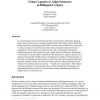Free Online Productivity Tools
i2Speak
i2Symbol
i2OCR
iTex2Img
iWeb2Print
iWeb2Shot
i2Type
iPdf2Split
iPdf2Merge
i2Bopomofo
i2Arabic
i2Style
i2Image
i2PDF
iLatex2Rtf
Sci2ools
CASCON
1993
1993
Using cognates to align sentences in bilingual corpora
In a recent paper, Gale and Church describe an inexpensive method for aligning bitext, based exclusively on sentence lengths [Gale and Church, 1991]. While this method produces surprisingly good results (a success rate around 96%), even better results are required to perform such tasks as the computer-assisted revision of translations. In this paper, we examine some of the weaknesses of Gale and Church’s program, and explain how just a small amount of linguistic knowledge would help to overcome these weaknesses. We discuss how cognates provide for a cheap and reasonably reliable source of linguistic knowledge. To illustrate this, we describe a modification to the program in which the criterion is cognates rather than sentence lengths. Finally, we show how better and more efficient results may be obtained by combining the two criteria — length and “cognateness”. Our method can be generalized to accommodate other sources of linguistic knowledge, and experimentation shows that ...
| Added | 02 Nov 2010 |
| Updated | 02 Nov 2010 |
| Type | Conference |
| Year | 1993 |
| Where | CASCON |
| Authors | Michel Simard, George F. Foster, Pierre Isabelle |
Comments (0)

